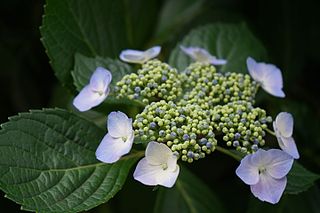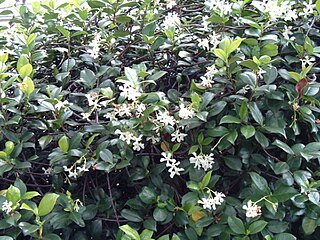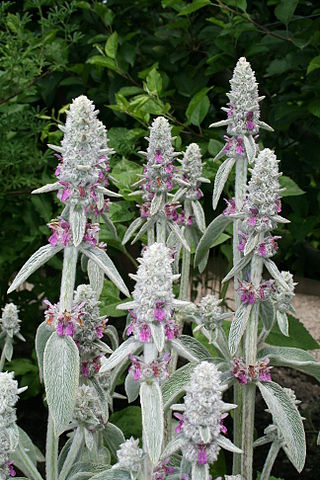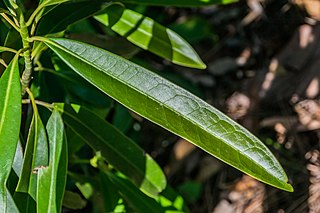
Magnolia virginiana, most commonly known as sweetbay magnolia, or merely sweetbay, is a member of the magnolia family, Magnoliaceae. It was the first magnolia to be scientifically described under modern rules of botanical nomenclature, and is the type species of the genus Magnolia; as Magnolia is also the type genus of all flowering plants (magnoliophytes), this species in a sense typifies all flowering plants.

Magnolia grandiflora, commonly known as the southern magnolia or bull bay, is a tree of the family Magnoliaceae native to the Southeastern United States, from Virginia to central Florida, and west to East Texas. Reaching 27.5 m (90 ft) in height, it is a large, striking evergreen tree, with large, dark-green leaves up to 20 cm long and 12 cm wide, and large, white, fragrant flowers up to 30 cm (12 in) in diameter.

Pieris is a genus of seven species of shrubs in the flowering plant family Ericaceae, native to mountain regions of eastern and southern Asia, eastern North America and Cuba. Known commonly in North America as andromedas or fetterbushes, they are broad-leaved evergreen shrubs growing to 1–6 metres tall and 3–10 ft (0.9–3.0 m) wide. The leaves are spirally arranged, often appearing to be in whorls at the end of each shoot with bare stretches of shoot below; they are lanceolate-ovate, 2–10 cm (0.8–3.9 in) long and 1.0–3.5 cm (0.4–1.4 in) broad, leathery textured, and with an entire or serrated margin. The young leaves in spring are typically brightly coloured. The flowers, which may have a very appealing honey scent, are bell-shaped, 5–15 mm (0.2–0.6 in) long, white or pink, and arranged in racemes 5–12 cm (2.0–4.7 in) long. The fruit is a woody capsule which splits into five sections to release the numerous small seeds.

Magnolia fraseri, commonly known as Fraser magnolia, mountain magnolia, earleaf cucumbertree, or mountain-oread, is a species of magnolia native to the southeastern United States in the southern Appalachian Mountains and adjacent Atlantic and Gulf Coastal Plain from West Virginia to northern Florida and to eastern Texas. The Appalachian plants are classified as Magnolia fraseri var. fraseri, and the more coastal plants as M. fraseri var. pyramidata. These two kinds of magnolia are often recognized as distinct species, M. fraseri and M. pyramidata, respectively.

Magnolia denudata, the lilytree or Yulan magnolia, is native to central and eastern China. It has been cultivated in Chinese Buddhist temple gardens since 600 AD. Its flowers were regarded as a symbol of purity in the Tang dynasty and it was planted in the grounds of the emperor's palace. It is the official city flower of Shanghai.

Magnolia wilsonii, or Wilson's magnolia, is a species of Magnolia native to China, in the provinces of western Guizhou, Sichuan and northern Yunnan, where it grows in the forest understory at altitudes of 1,900-3,000 m, rarely up to 3,300 m.

Magnolia sieboldii, or Siebold's magnolia, also known as Korean mountain magnolia and Oyama magnolia, is a species of Magnolia native to east Asia in China, Japan, and Korea. It is named after the German doctor Philipp Franz von Siebold (1796–1866).

Magnolia delavayi is a species of flowering plant in the genus Magnolia. It is known by the common names of Chinese evergreen magnolia or Delavay's magnolia. It was named after Father Delavay, French Catholic missionary in China, who collected it.

Magnolia officinalis is a species of Magnolia native to the mountains and valleys of China at altitudes of 300–1500 m.

Hydrangea anomala, the Japanese climbing-hydrangea, is a species of flowering plant in the family Hydrangeaceae native to the woodlands of the Himalaya, southern and central China and northern Myanmar.

Hosta is a genus of plants commonly known as hostas, plantain lilies and occasionally by the Japanese name gibōshi. Hostas are widely cultivated as shade-tolerant foliage plants. The genus is currently placed in the family Asparagaceae, subfamily Agavoideae, and is native to northeast Asia. Like many "lilioid monocots", the genus was once classified in the Liliaceae. The genus was named by Austrian botanist Leopold Trattinnick in 1812, in honor of the Austrian botanist Nicholas Thomas Host. In 1817, the generic name Funkia was used by German botanist Kurt Sprengel in honor of Heinrich Christian Funck, a collector of ferns and alpines; this was later used as a common name and can be found in some older literature.

Trachelospermumstar jasmine, Confederate jasmine, is a genus of evergreen woody vines in the dogbane family Apocynaceae, first described as a genus in 1851. All species are native to southern and eastern Asia.

Nandina domestica commonly known as nandina, heavenly bamboo or sacred bamboo, is a species of flowering plant in the family Berberidaceae, native to eastern Asia from the Himalayas to Japan. It is the only member of the monotypic genus Nandina. It is widely grown in gardens as an ornamental plant with a number of cultivars that display bright-red fall foliage in the cool months, and attractive new foliage growth in spring. Although a popular ornamental shrub, the berries are toxic to birds, especially towards the end of the winter when other food sources become scarce.

Magnolia hodgsonii, known in Chinese as gai lie mu is a species of Magnolia native to the forests of the Himalaya and southeastern Asia, occurring in Bhutan, southwestern China, Tibet, northeastern India, northern Myanmar, Nepal, and Thailand. It grows at moderate altitudes of 850–1500 m with a subtropical climate.

Codiaeum variegatum is a species of Codiaeum, a genus of flowering plants, in the Euphorbiaceae. Initially described by Carl Linnaeus in 1753, it is native to Australasia and Oceania, from Malaysia and Indonesia in the north through northeastern Australia, as well as many Southeast Asian and South Pacific islands, growing in open forests and scrub.

Stachys byzantina, the lamb's-ear or woolly hedgenettle, is a species of flowering plant in the mint family Lamiaceae, native to Armenia, Iran, and Turkey. It is cultivated throughout much of the temperate world as an ornamental plant, and is naturalised in some locations as an escapee from gardens. Plants are very often found under the synonym Stachys lanata or Stachys olympica.

Acer davidii, or Père David's maple, is a species of maple in the snakebark maple group. It is native to China, from Jiangsu south to Fujian and Guangdong, and west to southeastern Gansu and Yunnan.

Lysimachia congestiflora, known as golden globes loosestrife or creeping Jenny, is a species of flowering plant in the primrose family Primulaceae. It is native to southeast Asia.

Magnolia biondii, or Biondi's magnolia, is a deciduous tree that flowers in late winter to early spring before leaf growth. Its early flowering nature gives it the name of the Hope for Spring Flower.

Magnolia insignis, the red lotus tree, is a species of flowering plant in the family Magnoliaceae, native to Nepal, Assam, Tibet, southern China, Myanmar, Thailand and Vietnam. It is used as a street tree in a number of southern Chinese cities.



















